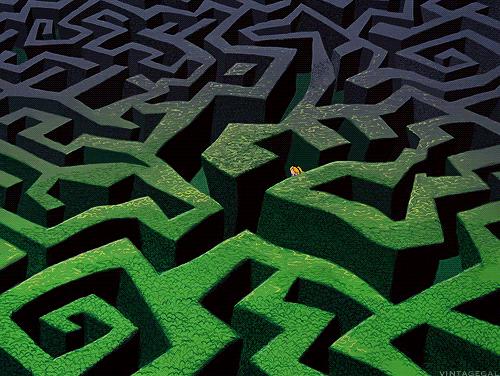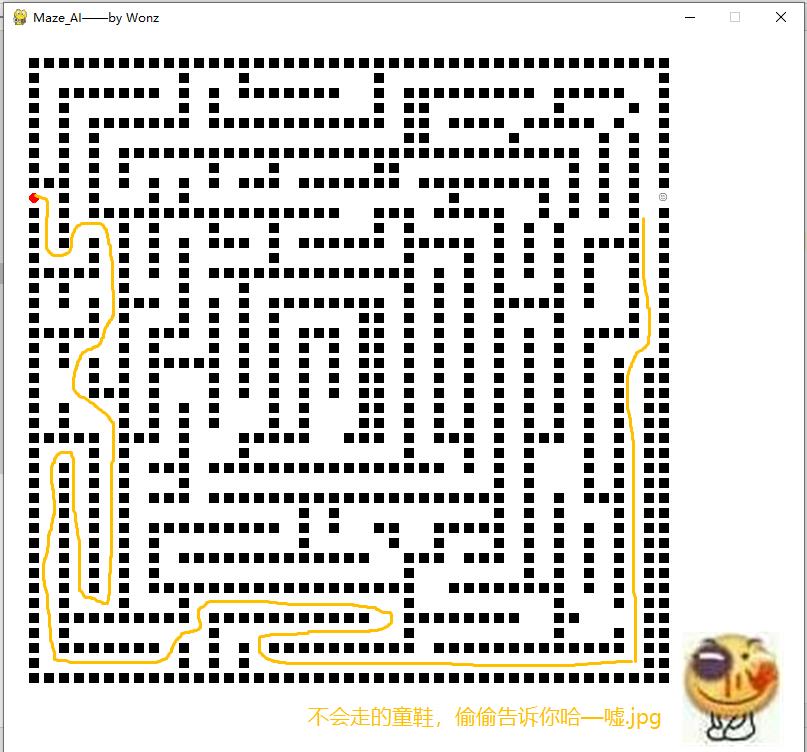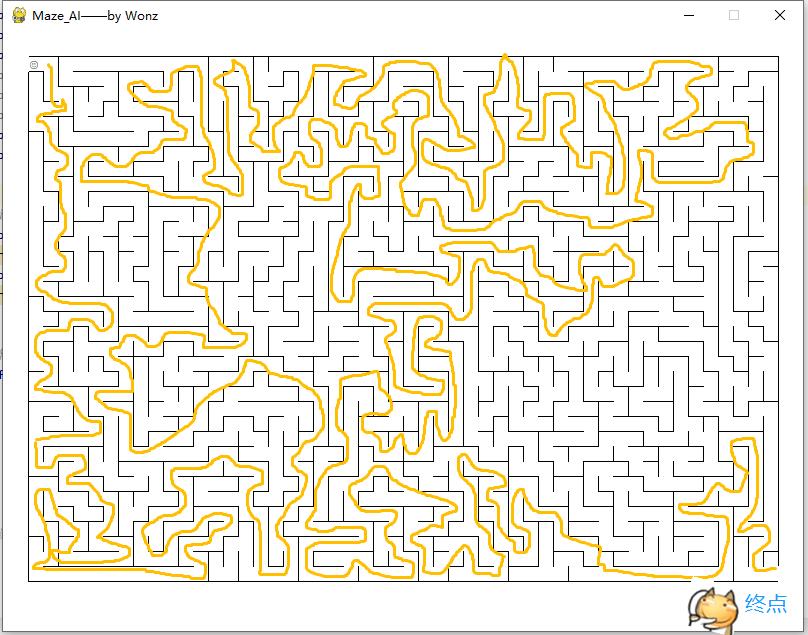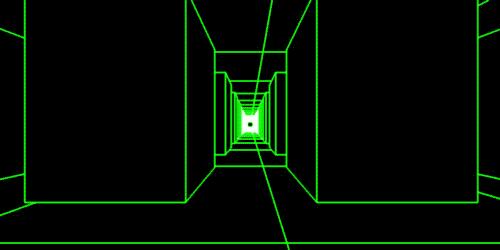Pygame小游戏Python版有迷宫嘛?原来藏在个地方呀~
Posted 嗨!程序媛
tags:
篇首语:本文由小常识网(cha138.com)小编为大家整理,主要介绍了Pygame小游戏Python版有迷宫嘛?原来藏在个地方呀~相关的知识,希望对你有一定的参考价值。
💦前言

大家好,是我:
一大早高清无码好东西刚到手
就给大家安排推文的栗子同学上线·放牛小编——一切随缘更新+慢更新的我!
决心痛改前非,每周争取能多写几篇。(这个flag立在这里,完不成......那就算了!)
大家有时候会和朋友聊聊孩子,说起能让孩子心无旁骛的制胜法宝,我想大家应该一致认为“迷宫”
必须当选其一👏。迷宫类游戏也是大家闲暇实践之中消磨时间的法宝。
嘿!boys and girs——今天栗子给大家带来一波有趣好玩的走迷宫小程序。

💦 正文

游戏规则:顾名思义,玩家出现在迷宫的外面,进入之后要在很多不同的路中间找到一条可以抵达
终点的路,可以发反复的尝试,能走到终点就是胜利,当人你如果在迷宫中迷路了,就走不出来会
失败。迷宫游戏则倾向于吸引那些更有兴趣解决谜题和迎接挑战的人群。
1)需要做哪些准备呢?
本文的游戏迷宫是2个单独的迷宫组合而成的,一个简单的迷宫,一个难的迷宫。
环境安装的话:Python3、Pycharm、Pygame模块。
模块安装:pip install pygame
2)代码(仅部分)
简易版主程序:
import pygame
import sys
import random
import time
from pygame.locals import *
from random import randint, choice
import mapp
import color
# 设置屏幕宽度和高度为全局变量
global screen_width
screen_width = 800
global screen_height
screen_height = 800
room_size = 15 # 每个房间的大小
steps = 0
# 输出文本信息
def print_text(font, x, y, text, color, shadow=True):
if shadow:
imgText = font.render(text, True, (0, 0, 0))
screen.blit(imgText, (x-2,y-2))
imgText = font.render(text, True, color)
screen.blit(imgText, (x,y))
# 存储迷宫
r_list = mapp.map_list
# 游戏开始
if __name__ == '__main__':
# 初始化 Pygame
pygame.init()
screen = pygame.display.set_mode([screen_width, screen_height])
pygame.display.set_caption('Maze_AI——by Wonz')
global font1, font2, font3
clock = pygame.time.Clock()
fps = 20
screen.fill(color.White)
# 加载角色照片
user = pygame.image.load("user.png").convert_alpha()
width, height = user.get_size()
user = pygame.transform.smoothscale(user, (8, 8))
# draw the user
width, height = user.get_size()
x = 25 + 42 * room_size
y = 25 + 9 * room_size
roomx = 42
roomy = 9
screen.blit(user, (x, y))
# 画迷宫
for i in range(43):
for j in range(42):
if (r_list[j][i] == 3):
pygame.draw.circle(screen, color.Red, [30 + i * room_size, 30 + j * room_size], 5, 0)
pygame.display.flip()
r_list[j][i] = 0
elif (r_list[j][i] == 1):
# 画10*10的矩形,线宽为1,这里不能是0,因为10*10无空白区域
pygame.draw.rect(screen, color.Black, [25 + i * room_size, 25 + j * room_size, 10, 10], 0)
pygame.display.flip()
elif (r_list[j][i] == 0):
pygame.draw.rect(screen, color.White, [25 + i * room_size, 25 + j * room_size, 10, 10], 1)
pygame.display.flip()
while True:
for event in pygame.event.get():
if event.type == pygame.QUIT:
sys.exit()
# 走到终点
elif(roomx == 0 and roomy == 9):
font3 = pygame.font.Font(None, 32)
print_text(font3, 350, 350, "Win", color.Red)
break
elif event.type == pygame.KEYDOWN:
if event.key == pygame.K_RIGHT:
# 右边无墙
if(0 <= roomx < 42 and 0 <= roomy <= 41 and r_list[roomy][roomx+1] == 0):
x += room_size
roomx += 1 # 计房间数
steps += 1 # 计步
font1 = pygame.font.Font(None, 32)
screen.fill(color.White, (25, 0, 200, 25)) # x:25 y:0 width:200 height:25
screen.fill(color.White, (300, 0, 200, 25)) # x:300 y:0 width:200 height:25
print_text(font1, 25, 0, "Steps:" + str(steps), color.Black)
pygame.display.flip()
screen.fill(color.White, (x-room_size, y, 10, 10))
screen.blit(user, (x, y))
# 右边有墙
elif (0 <= roomx < 42 and 0 <= roomy <= 41 and r_list[roomy][roomx+1] == 1):
steps += 1
font1 = pygame.font.Font(None, 32)
font2 = pygame.font.Font(None, 32)
screen.fill(color.White, (25, 0, 200, 25))
print_text(font1, 25, 0, "Steps:" + str(steps), color.Black)
print_text(font2, 350, 0, "This is a wall!", color.Black)
pygame.display.flip()
screen.blit(user, (x, y))
elif event.key == pygame.K_LEFT:
# 左边无墙
if (0 < roomx <= 42 and 0 <= roomy <= 41 and r_list[roomy][roomx-1] == 0):
x -= room_size
roomx -= 1
steps += 1
font1 = pygame.font.Font(None, 32)
screen.fill(color.White, (25, 0, 200, 25))
screen.fill(color.White, (300, 0, 200, 25)) # x:300 y:0 width:200 height:25
print_text(font1, 25, 0, "Steps:" + str(steps), color.Black)
pygame.display.flip()
screen.fill(color.White, (x+room_size, y, 10, 10))
screen.blit(user, (x, y))
# 左边有墙
elif (0 < roomx <= 42 and 0 <= roomy <= 41 and r_list[roomy][roomx-1] == 1):
steps += 1
font1 = pygame.font.Font(None, 32)
font2 = pygame.font.Font(None, 32)
screen.fill(color.White, (25, 0, 200, 25))
print_text(font1, 25, 0, "Steps:" + str(steps), color.Black)
print_text(font2, 350, 0, "This is a wall!", color.Black)
pygame.display.flip()
screen.blit(user, (x, y))
elif event.key == pygame.K_UP:
# 上边无墙
if (0 <= roomx <= 42 and 0 < roomy <= 41 and r_list[roomy-1][roomx] == 0):
y -= room_size
roomy -= 1
steps += 1
font1 = pygame.font.Font(None, 32)
screen.fill(color.White, (25, 0, 200, 25))
screen.fill(color.White, (300, 0, 200, 25)) # x:300 y:0 width:200 height:25
print_text(font1, 25, 0, "Steps:" + str(steps), color.Black)
pygame.display.flip()
screen.fill(color.White, (x, y+room_size, 10, 10))
screen.blit(user, (x, y))
# 上边有墙
elif (0 <= roomx <= 42 and 0 < roomy <= 41 and r_list[roomy-1][roomx] == 1):
steps += 1
font1 = pygame.font.Font(None, 32)
font2 = pygame.font.Font(None, 32)
screen.fill(color.White, (25, 0, 200, 25))
print_text(font1, 25, 0, "Steps:" + str(steps), color.Black)
print_text(font2, 350, 0, "This is a wall!", color.Black)
pygame.display.flip()
screen.blit(user, (x, y))
elif event.key == pygame.K_DOWN:
# 下边无墙
if (0 <= roomx <= 42 and 0 <= roomy < 41 and r_list[roomy+1][roomx] == 0):
y += room_size
roomy += 1
steps += 1
font1 = pygame.font.Font(None, 32)
screen.fill(color.White, (25, 0, 200, 25))
screen.fill(color.White, (300, 0, 200, 25)) # x:300 y:0 width:200 height:25
print_text(font1, 25, 0, "Steps:" + str(steps), color.Black)
pygame.display.flip()
screen.fill(color.White, (x, y-room_size, 10, 10))
screen.blit(user, (x, y))
# 下边无墙
elif (0 <= roomx <= 42 and 0 <= roomy < 41 and r_list[roomy+1][roomx] == 1):
steps += 1
font1 = pygame.font.Font(None, 32)
font2 = pygame.font.Font(None, 32)
screen.fill(color.White, (25, 0, 200, 25))
print_text(font1, 25, 0, "Steps:" + str(steps), color.Black)
print_text(font2, 350, 0, "This is a wall!", color.Black)
pygame.display.flip()
screen.blit(user, (x, y))
# 更新屏幕
pygame.display.update()难版迷宫主程序:
import pygame
import sys
import random
import time
from pygame.locals import *
from random import randint, choice
import maze
import color
# 设置屏幕宽度和高度为全局变量
global screen_width
screen_width = 800
global screen_height
screen_height = 600
# 输出文本信息
def print_text(font, x, y, text, color, shadow=True):
if shadow:
imgText = font.render(text, True, (0, 0, 0))
screen.blit(imgText, (x-2,y-2))
imgText = font.render(text, True, color)
screen.blit(imgText, (x,y))
# 游戏开始
if __name__ == '__main__':
pygame.init()
screen = pygame.display.set_mode([screen_width, screen_height])
pygame.display.set_caption('Maze_AI——by Wonz') # 游戏标题
global font1, font2, font3, font4 # 文字
clock = pygame.time.Clock()
fps = 20
screen.fill(color.White)
r_list = maze.room.creat_map(maze.room_m, maze.room_n)
begin_point = [0, 0]
begin_room = r_list[0][0]
maze.room.creat_migong(r_list, begin_room)
# 画出去起点和终点的其他点
for i in range(maze.room_m):
for j in range(maze.room_n):
begin_point[0] = 25 + i * maze.room_size
begin_point[1] = 25 + j * maze.room_size
r_color = color.Black
maze.room.draw_room(screen, begin_point, r_list[i][j].walls, maze.room_size, r_color)
# 画起点
maze.room.draw_room(screen, [25, 25], [0, 0, 0, 1], maze.room_size, color.White)
# 画终点
maze.room.draw_room(screen, [25 + (maze.room_m - 1) * maze.room_size, 25 + (maze.room_n - 1) * maze.room_size],
[0, 1, 0, 0], maze.room_size, color.White)
# 加载角色照片
user = pygame.image.load("user.png").convert_alpha()
width,height = user.get_size()
user = pygame.transform.smoothscale(user, (8,8))
# 画角色
width, height = user.get_size()
x = 27
y = 30
roomx = 0
roomy = 0
screen.blit(user, (x, y))
# 键盘控制角色移动
while True:
for event in pygame.event.get():
if event.type == pygame.QUIT:
sys.exit()
# 走到终点
elif(roomx == maze.room_m-1 and roomy == maze.room_n-1):
font4 = pygame.font.Font(None, 32)
print_text(font4, 350, 350, "Win" , color.Red)
break
# 键盘响应,只取按“→”键作为例子,“↑”、“↓”、“←”类似,只要改改参数即可
elif event.type == pygame.KEYDOWN:
if event.key == pygame.K_RIGHT:
# 右边无墙
if(r_list[roomx][roomy].walls[1] == False):
x += maze.room_size
roomx += 1 # 计房间数
maze.steps += 1 # 计步
font1 = pygame.font.Font(None, 32)
screen.fill(color.White, (25, 0, 200, 25)) # x:25 y:0 width:200 height:25
screen.fill(color.White, (300, 0, 200, 25)) # x:300 y:0 width:200 height:25
print_text(font1, 25, 0, "Steps:" + str(maze.steps), color.Black)
pygame.display.flip()
screen.fill(color.White, (x-15,y,10,10))
screen.blit(user, (x, y))
# 右边有墙
elif (r_list[roomx][roomy].walls[1] == True):
maze.steps += 1
font1 = pygame.font.Font(None, 32)
font2 = pygame.font.Font(None, 32)
screen.fill(color.White, (25, 0, 200, 25)) # x:25 y:0 width:200 height:25
print_text(font1, 25, 0, "Steps:" + str(maze.steps), color.Black)
print_text(font2, 350, 0, "This is a wall!", color.Black)
pygame.display.flip()
screen.blit(user, (x, y))
elif event.key == pygame.K_LEFT:
# 左边无墙
if (r_list[roomx][roomy].walls[3] == False):
x -= maze.room_size
roomx -= 1
maze.steps += 1
font1 = pygame.font.Font(None, 32)
screen.fill(color.White, (25, 0, 200, 25))
screen.fill(color.White, (300, 0, 200, 25)) # x:300 y:0 width:200 height:25
print_text(font1, 25, 0, "Steps:" + str(maze.steps), color.Black)
pygame.display.flip()
screen.fill(color.White, (x+15,y,10,10))
screen.blit(user, (x, y))
# 左边有墙
elif (r_list[roomx][roomy].walls[3] == True):
maze.steps += 1
font1 = pygame.font.Font(None, 32)
font2 = pygame.font.Font(None, 32)
screen.fill(color.White, (25, 0, 200, 25))
print_text(font1, 25, 0, "Steps:" + str(maze.steps), color.Black)
print_text(font2, 350, 0, "This is a wall!", color.Black)
pygame.display.flip()
screen.blit(user, (x, y))
elif event.key == pygame.K_UP:
# 上边无墙
if (r_list[roomx][roomy].walls[0] == False):
y -= maze.room_size
roomy -= 1
maze.steps += 1
font1 = pygame.font.Font(None, 32)
screen.fill(color.White, (25, 0, 200, 25))
screen.fill(color.White, (300, 0, 200, 25)) # x:300 y:0 width:200 height:25
print_text(font1, 25, 0, "Steps:" + str(maze.steps), color.Black)
pygame.display.flip()
screen.fill(color.White, (x,y+15,10,10))
screen.blit(user, (x, y))
# 上边有墙
elif (r_list[roomx][roomy].walls[0] == True):
maze.steps += 1
font1 = pygame.font.Font(None, 32)
font2 = pygame.font.Font(None, 32)
screen.fill(color.White, (25, 0, 200, 25))
print_text(font1, 25, 0, "Steps:" + str(maze.steps), color.Black)
print_text(font2, 350, 0, "This is a wall!", color.Black)
pygame.display.flip()
screen.blit(user, (x, y))
elif event.key == pygame.K_DOWN:
# 下边无墙
if (r_list[roomx][roomy].walls[2] == False):
y += maze.room_size
roomy += 1
maze.steps += 1
font1 = pygame.font.Font(None, 32)
screen.fill(color.White, (25, 0, 200, 25))
screen.fill(color.White, (300, 0, 200, 25)) # x:300 y:0 width:200 height:25
print_text(font1, 25, 0, "Steps:" + str(maze.steps), color.Black)
pygame.display.flip()
screen.fill(color.White, (x,y-15,10,10))
screen.blit(user, (x, y))
# 下边无墙
elif (r_list[roomx][roomy].walls[2] == True):
maze.steps += 1
font1 = pygame.font.Font(None, 32)
font2 = pygame.font.Font(None, 32)
screen.fill(color.White, (25, 0, 200, 25))
print_text(font1, 25, 0, "Steps:" + str(maze.steps), color.Black)
print_text(font2, 350, 0, "This is a wall!", color.Black)
pygame.display.flip()
screen.blit(user, (x, y))
# 鼠标响应,执行 AI 程序
elif event.type == pygame.MOUSEBUTTONUP:
font3 = pygame.font.Font(None, 32)
print_text(font3, 750, 0, "AI", color.Red)
pygame.display.flip()
start_x = 0
start_y = 0
steps = 0
for i in range(1000000000):
if (start_x == maze.room_m-1 and start_y == maze.room_n-1):
font4 = pygame.font.Font(None, 32)
print_text(font4, 350, 350, "Win", color.Red)
break
d = random.randint(1,4)
# 上边无墙
if (d == 1 and 0 <= start_x <= maze.room_m - 1 and 0 <= start_y <= maze.room_n - 1 and
r_list[start_x][start_y].walls[0] == False): # 在迷宫地图范围内且上边无墙
start_y -= 1
steps += 1
font1 = pygame.font.Font(None, 32)
screen.fill(color.White, (25, 0, 200, 25)) # x:25 y:0 width:200 height:25
screen.fill(color.White, (300, 0, 200, 25)) # x:300 y:0 width:200 height:25
print_text(font1, 25, 0, "Steps:" + str(steps), color.Black) # 步数统计
pygame.display.flip()
screen.blit(user, ((start_x+2) * maze.room_size, (start_y+2) * maze.room_size))
# 右边无墙
if (d == 2 and 0 <= start_x <= maze.room_m - 1 and 0 <= start_y <= maze.room_n - 1 and
r_list[start_x][start_y].walls[1] == False):
start_x += 1
steps += 1
font1 = pygame.font.Font(None, 32)
screen.fill(color.White, (25, 0, 200, 25))
screen.fill(color.White, (300, 0, 200, 25))
print_text(font1, 25, 0, "Steps:" + str(steps), color.Black)
pygame.display.flip()
screen.blit(user, ((start_x+2) * maze.room_size, (start_y+2) * maze.room_size))
# 下边无墙
if (d == 3 and 0 <= start_x <= maze.room_m - 1 and 0 <= start_y <= maze.room_n - 1 and
r_list[start_x][start_y].walls[2] == False):
start_y += 1
steps += 1
font1 = pygame.font.Font(None, 32)
screen.fill(color.White, (25, 0, 200, 25))
screen.fill(color.White, (300, 0, 200, 25))
print_text(font1, 25, 0, "Steps:" + str(steps), color.Black)
pygame.display.flip()
screen.blit(user, ((start_x+2) * maze.room_size, (start_y+2) * maze.room_size))
# 左边无墙
if (d == 4 and 0 <= start_x <= maze.room_m - 1 and 0 <= start_y <= maze.room_n - 1 and
r_list[start_x][start_y].walls[3] == False):
start_x -= 1
steps += 1
font1 = pygame.font.Font(None, 32)
screen.fill(color.White, (25, 0, 200, 25))
screen.fill(color.White, (300, 0, 200, 25))
print_text(font1, 25, 0, "Steps:" + str(steps), color.Black)
pygame.display.flip()
screen.blit(user, ((start_x+2) * maze.room_size, (start_y+2) * maze.room_size))
# 更新屏幕
pygame.display.update()3)效果展示
简易版——

难版——

哈哈哈~栗子很好滴 2个版本的路线都给大家标出来啦,不会的跟着走不会错哦!

💦结尾
悄悄告诉你,这条迷宫我是一眼就看出来了173步就可以完美走出来哦。你来试试嘛?
怎么样,挑战成功了吗?
完整的项目源码免费领:关注小编公众号:Python顾木子吖

如果你喜欢,请“点赞” “关注” “评论”给我小心心吧


以上是关于Pygame小游戏Python版有迷宫嘛?原来藏在个地方呀~的主要内容,如果未能解决你的问题,请参考以下文章